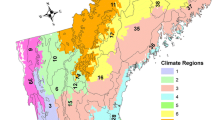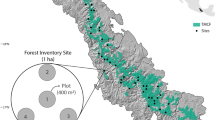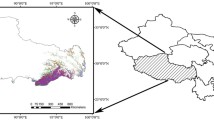Abstract
Context
Forests in the northeastern United States are currently in early- and mid-successional stages recovering from historical land use. Climate change will affect forest distribution and structure and have important implications for biodiversity, carbon dynamics, and human well-being.
Objective
We addressed how aboveground biomass (AGB) and tree species distribution changed under multiple climate change scenarios (PCM B1, CGCM A2, and GFDL A1FI) in northeastern forests.
Methods
We used the LANDIS PRO forest landscape model to simulate forest succession and tree harvest under current climate and three climate change scenarios from 2000 to 2300. We analyzed the effects of climate change on AGB and tree species distribution.
Results
AGB increased from 2000 to 2120 irrespective of climate scenario, followed by slight decline, but then increased again to 2300. AGB averaged 10 % greater in the CGCM A2 and GFDL A1FI scenarios than the PCM B1 and current climate scenarios. Climate change effects on tree species distribution were not evident from 2000 to 2100 but by 2300 some northern hardwood and conifer species decreased in occurrence and some central hardwood and southern tree species increased in occurrence.
Conclusions
Climate change had positive effects on forest biomass under the two climate scenarios with greatest warming but the patterns in AGB over time were similar among climate scenarios because succession was the primary driver of AGB dynamics. Our approach, which simulated stand dynamics and dispersal, demonstrated that a northward shift in tree species distributions may take 300 or more years.






Similar content being viewed by others
References
Albani M, Medvigy D, Hurtt G, Moorcroft PR (2006) The contributions of land-use change, CO2 fertilization, and climate variability to the Eastern carbon sink. Glob Change Biol 12:2370–2390
Anderegg WRL, Hicke JA, Fisher RA, Allen CD, Aukema J, Bentz B, Hood S, Lichstein JW, Macalady AK, McDowell N, Raffa K, Pan Y, Sala A, Shaw J, Stephenson NL, Tague C, Zeppel M (2015) Tree mortality from drought, insects, and their interactions in a changing climate. New Phytol 208:674–683
Bachelet D, Ferschweiler K, Sheehan TJ, Sleeter BM, Zhu Z (2015) Projected carbon stocks in the conterminous USA with land use and variable fire regimes. Glob Change Biol 21:4548–4560
Bormann FH, Likens GE (1979) Pattern and process in a forested ecosystem: disturbance, development, and the steady state based on the Hubbard Brook ecosystem study. Springer-Verlag, New York
Brandt L, He H, Iverson L, Thompson FR, Butler P, Handler S, Janowiak M, Shannon PD, Swanston C, Albrecht M, Blume-Weaver R, Deizman P, DePuy J, Dijak WD, Dinkel G, Fei S, Jones-Farrand DT, Leahy M, Matthews S, Nelson P, Oberle B, Perez J, Peters M, Prasad A, Schneiderman JE, Shuey J, Smith AB, Studyvin C, Tirpak JM, Walk JW, Wang WJ, Watts L, Weigel D, Westin S (2014) Central Hardwoods ecosystem vulnerability assessment and synthesis: a report from the Central Hardwoods climate change response framework project. U.S. Department of Agriculture, Forest Service, Northern Research Station, general technical report NRS-124, Newtown Square
Burns RM, Honkala BH (Tech. Coords.) (1990) Silvics of North America: 1. conifers; 2. hardwoods. Agriculture Handbook 654, USDA Forest Service, Washington, DC
Canham CD, Rogers N, Buchholz T (2013) Regional variation in forest harvest regimes in the northeastern United States. Ecol Appl 23(3):515–522
Cleland DT, Freeouf JA, Keys JE, Nowacki GJ, Carpenter C, McNab WH (2007) Ecological subregions: sections and subsections of the conterminous United States [1:3,500,000] [CD-ROM]. In: Sloan AM (Cartography) General technical report WO-76. U.S. Department of Agriculture, Forest Service, Washington, DC
Dale VH (2001) Climate change and forest disturbances. BioScience 51:723–734
Dijak W (2013) Landscape Builder: software for the creation of initial landscapes for LANDIS from FIA data. Comput Ecol Softw 3(2):17–25
Dijak W, Hanberry B, Fraser JS, He HS, Thompson FR III, Wang WJ (in press) Revision and application of the LINKAGES model to simulate forest growth in Central Hardwood landscapes in response to climate change. Landscape Ecol
Doxford SW, Freckleton RP (2012) Changes in the large-scale distribution of plants: extinction, colonization and the effects of climate. J Ecol 100:519–529
Duveneck MJ, Thompson JR, Gustafson EJ, De Bruijn AMG (2016) Recovery dynamics and climate change effects to future New England forests. Landscape Ecol. doi:10.1007/s10980-016-0415-5
Fraser JS, He HS, Shifley SR, Wang WJ, Thompson FR (2013) Simulating stand-level harvest prescriptions across landscapes: LANDIS PRO harvest module design. Can J For Res 43:972–978
Frumhoff PC, McCarthy JJ, Melillo JM, Moser SC, Wuebbles DJ (2007) Confronting climate change in the U.S. Northeast: science, impacts, and solutions. Synthesis report of the Northeast climate impacts assessment (NECIA). Union of Concerned Scientists (UCS), Cambridge
Gustafson EJ, Shvidenko AZ, Sturtevant BR, Scheller RM (2010) Predicting global change effects on forest biomass and composition in South-Central Siberia. Ecol Appl 20(3):700–715
He HS, Mladenoff DJ, Crow TR (1999) Linking an ecosystem model and a landscape model to study forest species response to climate warming. Ecol Model 114:213–233
He HS, Wang WJ, Fraser JS, Shifley SR, Larsen DR (2012) LANDIS: a spatially explicit model of forest landscape disturbance, management, and succession. LANDIS PRO 7.0 USERS GUIDE. University of Missouri, Columbia
IPCC (2007) Climate change 2007: the physical science basis. In: Solomon S, Qin D, Manning M, Chen Z, Marquis M, Averyt, KB, Tignore M, Miller HL (eds) Contribution of working Ggroup I to the fourth assessment report of the intergovernmental panel on climate change. Cambridge University Press, Cambridge, 996 pp
Iverson LR, Prasad AM, Matthews SN, Peters M (2008) Estimating potential habitat for 134 eastern US tree species under six climate scenarios. For Ecol Manag 254:390–406
Iverson LR, Prasad AM, Matthews SN, Peters MP (2011) Lessons learned while integrating habitat, dispersal, disturbance, and life-history traits into species habitat models under climate change. Ecosystems 14:1005–1020
Iverson LR, Thompson FR III, Matthews S, Peters M, Prasad A, Dijak WD, Fraser JS, Wang WJ, Hanberry B, He HS, Janowiak M, Butler P, Brandt L, Swanston C (2016) Multi-model comparison on the effects of climate change on tree species in the eastern U.S.: results from an enhanced niche model and process-based ecosystem and landscape models. Landscape Ecol. doi:10.1007/s10980-016-0404-8
Keeton WS, Whitman AA, McGee GC, Goodale CL (2011) Late-successional biomass development in northern hardwood-conifer forests of the northeastern United States. For Sci 57:489–505
Liang Y, He HS, Wang WJ, Fraser JS, Wu Z (2015) The site-scale processes affect species distribution predations of forest landscape models. Ecol Model 300(24):89–101
Lichstein JW, Wirth C, Horn HS, Pacala SW (2009) Biomass chronosequences of United States forests: implications for carbon storage and forest management. In: Wirth C (ed) Old-growth forests. Springer, Berlin, pp 301–341
Luo X, He HS, Liang Y, Wang WJ, Wu Z, Fraser JS (2014) Spatial simulation of the effect of fire and harvest on aboveground tree biomass in boreal forests of Northeast China. Landscape Ecol 29:1187–1200
MacCleery DW (2011) American forests: a history of resiliency and recovery. Forest History Society, Durham, p 71
McGarvey JC, Thompson JR, Epstein HE, Shugart HH (2015) Carbon storage in old-growth forests of the Mid-Atlantic: toward better understanding the eastern forest carbon sink. Ecology 96:311–317
McKenney DW, Pedlar JH, Lawrence KM, Campbell KL, Hutchinson MF (2007) Potential impacts of climate change on the distribution of North American trees. BioScience 57(11):939–948
McMahon SM, Harrison SP, Armbruster WS (2011) Improving assessment and modeling of climate change impacts on global terrestrial biodiversity. Trends Ecol Evol 26(5):249–259
McNab WH, Cleland DT, Freeouf JA, Keys JE, Nowacki GJ, Carpenter CA (2007) Description of “ecological subregions: section of the conterminous United States”. USDA Forest Service general technical report WO-76B, pp 1–57
Mohan JE, Cox RM, Iverson LR (2009) Composition and carbon dynamics of forests in northeastern North America in a future, warmer world. Can J For Res 39:213–230
Morin X, Thuiller W (2009) Comparing niche- and process-based models to reduce prediction uncertainty in species range shifts under climate change. Ecology 90(5):1301–1313
Murphy KR, Myors B (2003) Statistical power analysis: a simple and general model for traditional and modern hypothesis tests, 2nd edn. Lawrence Erlbaum Associates, Mahwah
Neilson RP, Pitelka LF, Solomon AM, Nathan R, Midgley GF, Fragoso JM, Lischke H, Thompson K (2005) Forecasting regional to global plant migration in response to climate change. BioScience 55(9):749–759
Normand S, Zimmermann NE, Schur FM, Lischke H (2014) Demography as the basis for understanding and predicting range dynamics. Ecography 37:1149–1154
Pan Y, Birdsey RA, Fang J, Houghton R, Kauppi PE, Kurz WA, Phillips OL, Shvidenko A, Lewis SL, Canadell JG, Ciais P, Jackson RB, Pacala SW, McGuire AD, Piao S, Rautiainen A, Sitch S, Hayes D (2011) A large and persistent carbon sink in the world’s forests. Science 19:988–993
Perschel RT, Evans AM, Summers MJ (2007) Climate change, carbon, and the forests of the Northeast. http://www.forestguild.org/publications/2007/ForestGuild_climate_carbon_forests.pdf
Purves DW, Pacala SW (2008) Predictive models of forest dynamics. Science 320(5882):1452–1453
Raciti SM, Fahey TJ, Thomas RQ, Woodbury PB, Driscoll CT, Carranti FJ, Foster DR, Gwyther PS, Hall BR, Hamburg SP, Jenkins JC, Neill C, Peery BW, Quigley EE, Sherman R, Vadeboncoeur MA, Weinstein DA, Wilson G (2012) Local scale carbon budgets and mitigation opportunities for the northeastern United States. BioScience 62:23–38
Shifley SR, Moser WK, Nowak DJ, Miles PD, Butler BJ, Aguilar FX, DeSantis RD, Greenfield EJ (2014) Five anthropogenic factors that will radically alter forest conditions and management needs in the Northern United States. For Sci 60(5):914–925
Soil Survey Staff, Natural Resources Conservation Service, United States Department of Agriculture (2012) Database for Missouri. (http://soils.usda.gov/). Accessed 1 June 2013
Stoner AMK, Hayhoe K, Yang X (2011) Downscaled climate projections by Katharine Hayhoe. (http://cida.usgs.gov/climate/hayhoe_projections.jsp). Accessed 1 Nov 2011
Thompson JR, Carpenter DN, Cogbill C, Foster DR (2013) Four centuries of change in northeastern U.S. forests. PLoS One. doi:10.1371/journal.pone.0072540
Thompson JR, Foster DR, Scheller RM, Kittredge D (2011) The influence of land use and climate change on forest biomass and composition in Massachusetts, USA. Ecol Appl 21(7):2425–2444
Thornton PE, Thornton MM, Mayer BW, Wilhelmi N, Wei Y, Cook RB (2012) Daymet: daily surface weather on a 1 km grid for North America, 1980–2012. Oak Ridge National Laboratory Distributed Active Archive Center, Oak Ridge. (http://daymet.ornl.gov/). Accessed 1 July 2011
Thuiller W, Brotons L, Araújo MB, Lavorel S (2004) Effects of restricting environmental range of data to project current and future species distributions. Ecography 27:165–172
Turner DP, Jacobson AJ, Ritts WD, Wang WL, Nemani R (2013) A large proportion of North America net ecosystem production is offset by emissions from harvested products, river/system evasion, and biomass burning. Glob Change Biol 19:3516–3528
Tyrrell LE, Crow TR (1994) Structural characteristics of old-growth hemlock–hardwood forests in relation to age. Ecology 75:370–386
Vanderwel MC, Purves DW (2014) How do disturbances and environmental heterogeneity affect the pace of forest distribution shifts under climate change? Ecography 37:10–20
Wang WJ, He HS, Fraser JS, Thompson FR III, Shifley SR, Spetich MA (2014a) LANDIS PRO: a landscape model that predicts forest composition and structure changes at regional scales. Ecography 37:225–229
Wang WJ, He HS, Spetich MA, Shifley SR, Thompson FR (2014b) Evaluating forest landscape model predictions using empirical data and knowledge. Environ Model Softw 62:230–239
Wang WJ, He HS, Spetich MA, Shifley SR, Thompson FR III, Fraser JS (2013b) Modeling the effects of harvest alternatives on mitigating oak decline in a Central Hardwood forest landscape. PLoS One 8(6):1–10
Wang WJ, He HS, Spetich MA, Shifley SR, Thompson FR III, Larsen DR, Fraser JS, Yang J (2013a) A large-scale forest landscape model incorporating multi-scale processes and utilizing forest inventory data. Ecosphere 4(9):106
Wang WJ, He HS, Thompson FR III, Fraser JS, Hanberry BB, Dijak WD (2015) The importance of succession, harvest, and climate change in determining future forest composition changes in U.S. Central Hardwood Forests. Ecosphere 6(12):277. http://dx.doi.org/10.1890/ES15-00238.1
Wang WJ, He HS, Thompson FR III, Fraser JS, Hanberry BB, Dijak WD (2016) Landscape- and regional-scale shifts in forest composition under climate change in the Central Hardwood region of the United States. Landscape Ecol 31:149–163
Weed AS, Ayres MP, Hicke J (2013) Consequences of climate change for biotic disturbances in North American forests. Ecol Monogr 83(4):441–470
Woudenberg SW, Conkling BL, O’Connell BM, LaPoint EB, Turner JA, Waddell KL (2010) The forest inventory and analysis database: database description and users manual version 4.0 for phase 2. General technical report RMRS-GTR-245. United States Department of Agriculture Forest Service, Rocky Mountain Research Station, Fort Collins, p 336
Wullschleger SD, Gunderson CA, Tharp ML, West DC, Post WM (2003) Simulated patterns of forest succession and productivity as a consequence of altered precipitation. In: Hanson PJ, Wullschleger SD (eds) North American temperate deciduous forest responses to changing precipitation regimes. Springer-Verlag, New York, pp 433–446
Xiao J, Liang Y, He HS, Thompson JR, Wang WJ, Fraser JS, Wu Z (in press) The formulations of site-scale processes affect landscape-scale forest change predictions: a comparison between LANDIS PRO and LANDIS-II forest landscape models. Landscape Ecol
Ziegler SS (2000) A comparison of structural characteristics between old-growth and post fire second-growth hemlockhardwood forests in Adirondack Park, New York, USA. Glob Ecol Biogeogr 9:373–389
Acknowledgments
This project was funded by the USDA Forest Service Northern Research Station, a cooperative agreement from the United States Geological Survey Northeast Climate Science Center, and the University of Missouri-Columbia. Its contents are solely the responsibility of the authors and do not necessarily represent views of the Northeast Climate Science Center or the USGS. This manuscript is submitted for publication with the understanding that the United States Government is authorized to reproduce and distribute reprints for Governmental purposes.
Author information
Authors and Affiliations
Corresponding author
Electronic supplementary material
Below is the link to the electronic supplementary material.
10980_2016_429_MOESM1_ESM.png
Appendix Fig 1. The predicted extinction (in red), colonization (in green), and persistence (in blue) rates for 24 tree species under PCM B1, CGCM A2, and GFDL A1FI modeling scenarios at 2050 in the northeastern United States. Supplementary material 1 (PNG 741 kb)
10980_2016_429_MOESM3_ESM.png
Appendix Fig 2. The predicted extinction (in red), colonization (in green), and persistence (in blue) rates for 24 tree species under PCM B1, CGCM A2, and GFDL A1FI modeling scenarios at 2100 in the northeastern United States. Supplementary material 3 (PNG 738 kb)
Rights and permissions
About this article
Cite this article
Wang, W.J., He, H.S., Thompson, F.R. et al. Changes in forest biomass and tree species distribution under climate change in the northeastern United States. Landscape Ecol 32, 1399–1413 (2017). https://doi.org/10.1007/s10980-016-0429-z
Received:
Accepted:
Published:
Issue Date:
DOI: https://doi.org/10.1007/s10980-016-0429-z




